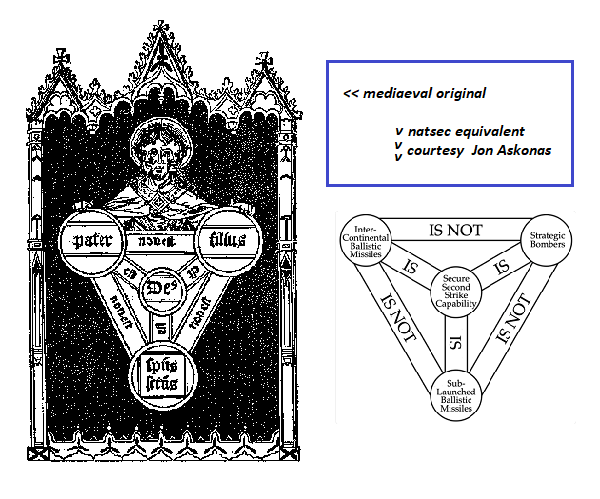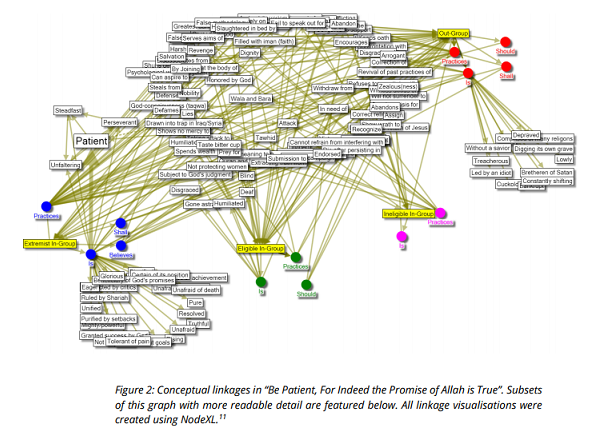On the felicities of graph-based game-board design: thirteen
Friday, December 21st, 2018[ by Charles Cameron — the Trinity and National Security, Game Boards and Mathematics, Japanese wave patterns, Maestro Harding on the interconnectedness of “all branches of human knowledge and curiosity, not just music” — plus Blues Clues at the tail end ]
.
Not only have the last couple of days been riotous in Washington, with more news to track than I have eyes to see, but today, still reeling under the weight of Mattis‘ resignation, McConnell‘s statement in support and other matters, I found myself with a richesse of board-game and graph-related delights.
**
Trinitarian NatSec:
Followers of this searies will be familiar with the Trinitarian diagram juxtaposed here with its equivalents from classical Kabballah and Oronce Fine:
That little triptych is from my religion and games avenues of interest, but of course I’m also interested in matters of national security, as befits Zenpundit, the strategy & creativity blog. You can imagine my surprise and delight, then, in coming across a natsec version of the trinity diagram, in a tweet from Jon Askonas.
Here’s my comparison:
My own attention was first drawn to the Trinitarian diagram as a result of reading Margaret Masterman‘s brilliant cross-disciplinary work, “Theism as a Scientific Hypothesis”, which ran in four parts in a somewhat obscure and difficult to find journal, Theoria to Theory, Vol 1, 1-4, 1966-67.
See:
Margaret Masterman, George Boole and the Holy Trinity Margaret Masterman’s “Theism as a Scientific Hypothesis”
**
Game Boards and Mathematics:
I could hardly fail to be intrigued by Calli Wright‘s piece titled The Big List of Board Games that Inspire Mathematical Thinking, eh? And look, the first game they show is a graph-based board game, Achi:
Dara also looks somewhat relevant.
**
Japanese wave designs:
Again, those familiar with my games will know of my juxtaposition of Von Kármán with Van Gogh as a DoubleQuote — but let me quote from an earlier post, Sunday’s second surprise — the Van Gogh DoubleQuote:
Here’s the Von Kármán / Van Gogh DQ, which I value in light of Hermann Hesse‘s Glass Bead Game as a clear bridge between one of the crucial dualities of recent centuries — the needless and fruitless schism between the arts and sciences, which has given rise not only the rantings of Christopher Hitchens and his less elegant disciple Bill Maher, but to such other matters as the Papal condemnation and “forgiveness” 359 years later of Galileo Galilei, Charles Babbage‘s Ninth Bridgewater Treatise, Andrew White‘s A History of the Warfare of Science With Theology in ChristendomW, and CP Snow‘s The Two Cultures:
And finally, here’s an ugraded version of the other DQ of mine that seeks to bridge the arts and sciences — featuring Hokusai‘s celebrated woodblock print, The Great Wave off Kanagawa (upper panel, below) and Jakob aka nikozy92‘s fractal wave, which I’ve flipped horizontally to make its parallel with the Hokusai clearer (lower panel) — Jakob‘s is a much improved version of a fractal wave compared with the one I’d been using until today:
That brings me to the Met’s marvelous offering, to which J Scott Shipman graciously pointed me:
Here’s where you get the collection:
Rich pickings!
**
Maestro Harding and the Glass Bead Game:
Finally, I’ve been delighted today to run across a couple of vdeos of my nephew, Maestro Daniel Harding, conducting the Swedish Radio Symphony Orchestra some years back in programs exploring the interplay of mathematics and other disciplines and music:
and:
Daniel is not working the graph-based angle that my games explore, but his thinking here is pleasantly congruous with my own. His work with the SRSO has, he says in the first video here, “to do with all branches of human knowledge and curiosity, not just music — because everything is connected”.
You can’t get much closer in spirit to Hesse‘s Glass Bead Game than that!
**
Earlier in this series:
On the felicities of graph-based game-board design: preliminaries On the felicities of graph-based game-board design: two dazzlers On the felicities of graph-based game-board design: three On the felicities of graph-based game-board design: four On the felicities of graph-based game-board design: five On the felicities of graph-based game-board design: six On the felicities of graph-based game-board design: seven On the felicities of graph-based game-board design: eight On the felicities of graph-based game-board design: nine On the felicities of graph-based game-board design: ten On the felicities of graph-based game-board design: eleven On the felicities of graph-based game-board design: twelve
**
BTW:
I really want to believe the only American television Kim Jong Un has watched is Blues Clues and that’s just what he thinks all American mail looks like. pic.twitter.com/wL9ek5csch
— Delaney Strunk (@delaknee) June 2, 2018
NatSec, yes, and a DoubleQUote. Too good to miss. Thanks again to John Askonas..













